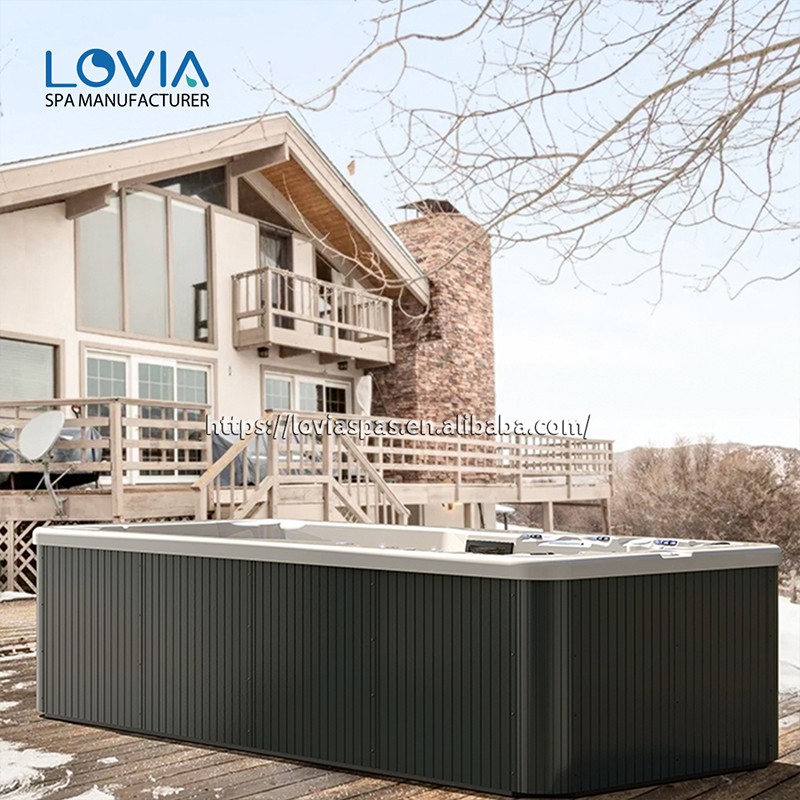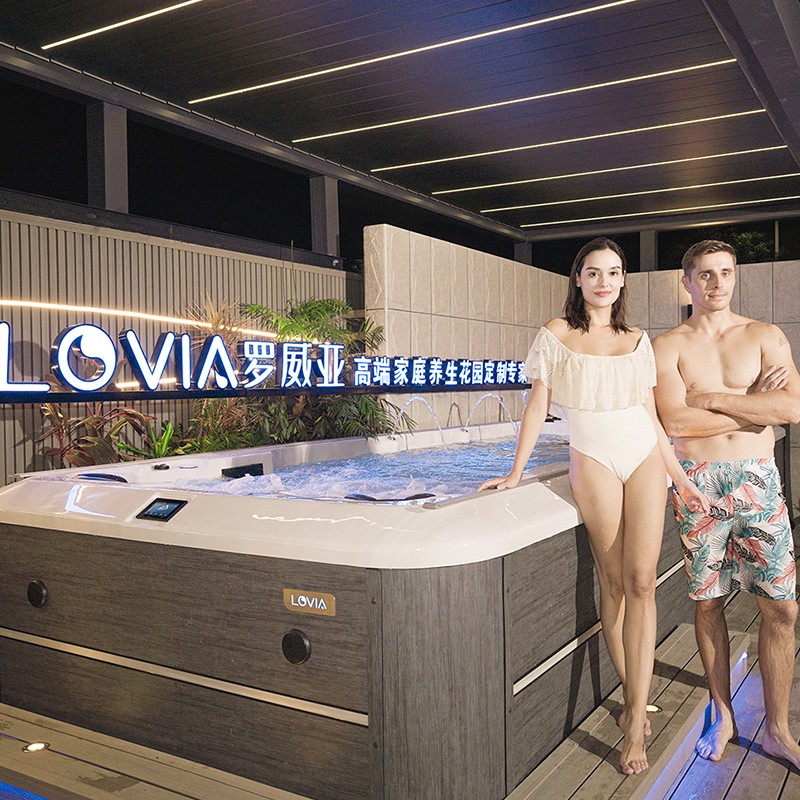
Can swim spa hot tubs cause fungal infections?
2025-11-06 15:35Modern families are increasingly favoring swim spa hot tubs that combine exercise and relaxation.
They offer both a constant-flow swimming experience and full-body hydrotherapy massage, allowing people to enjoy both fitness and relaxation at home.
However, many people wonder:
"Will frequent soaking in a swim spa hot tub cause fungal infections?"
After all, warm, humid environments seem to be a favorite habitat for mold and fungi.
This article will delve into this issue from a scientific perspective, helping you understand the principles of swim spa hot tub hygiene and learn effective preventive measures for healthier and safer use.

Why are some people concerned about fungal infections in swim spa hot tubs?
This concern is not unfounded.
In nature, fungi are commonly found in warm, humid environments, such as bathrooms, swimming pools, and locker rooms.
Swim spa hot tubs, with their high water temperature and humidity, have led some users to worry that they could become a breeding ground for fungi.
1. Warm water and humidity provide ideal conditions for fungi
The optimal growth temperature for fungi (such as Candida, Aspergillus, and mold) is approximately 25°C to 37°C, while the water temperature in a swim spa hot tub is typically set between 30°C and 39°C.
If water quality is not properly managed and the circulation system is not cleaned regularly, microorganisms can thrive.
2. Health risks for skin and shared surfaces
When bathing, flakes of skin, oil, and sweat enter the water.
If disinfection systems are inadequate or the water is used too frequently, organic matter accumulates in the water, potentially forming a "biofilm" that allows fungi to attach and multiply.
3. Misleading information and confusion
Many people mistake "hot tub rash" (a bacterial infection caused by Pseudomonas aeruginosa) for "fungal infection," misleadingly regarding the risks of swim spa hot tubs.
In reality, if properly maintained, a swim spa hot tub is not automatically a source of infection.
Is there a direct link between fungal infections and swim spa hot tubs?
The answer is: There's no direct causal relationship, but a potential risk exists.
In other words, a swim spa hot tub itself doesn't cause fungal infections, but if cleaning, filtration, and disinfection measures aren't adequate, it can indeed provide a suitable environment for fungi.
Let's analyze this potential relationship from a scientific perspective.
1. Conditions for Fungal Infection
Fungal infections typically require the following conditions to coexist:
• A compromised skin barrier;
• A hot, humid environment;
• Exposure to active fungal spores;
• A weakened immune system or an imbalanced skin microbiome.
Therefore, even if you come into contact with spa water, as long as the water is clean and your skin is healthy, fungi won't easily invade.
2. A swim spa hot tub's circulation and disinfection system effectively inhibits fungi
High-quality swim spa hot tubs are equipped with both a circulation and filtration system and a chemical disinfection system.
• The filtration system removes suspended impurities and skin flakes from the water;
• The disinfection system (usually using chlorine, bromine, or ozone) continuously inhibits bacterial and fungal growth;
• The constant temperature system ensures a stable water temperature, preventing environmental fluctuations that promote microbial growth. Therefore, as long as the system is functioning properly, fungi are unlikely to survive long-term in such an environment.

Where might fungi in a swim spa hot tub originate?
Fungal contamination is usually not due to equipment design issues, but rather to improper maintenance. The following are common causes.
1. Failure to clean the circulation piping for an extended period of time
The circulation system of a swim spa hot tub includes components such as piping, pumps, and nozzles.
If it is not operated for extended periods of time or is not cleaned regularly, residual water and organic matter can form a "biofilm," providing a breeding ground for fungi and bacteria.
2. Aging or failure to replace the filter cartridge promptly
The filter is a critical component for maintaining clean water quality.
If the filter cartridge is clogged or expired, impurities and spores can circulate in the system, contaminating the water.
3. Failure to drain and cover the tub promptly after use
If the tub is not drained or covered after use, dust and spores from the air can enter the water. Combined with the ideal temperature, fungi can easily multiply.
4. Inadequate disinfectant concentration
Some users excessively reduce the amount of chlorine or bromine added for skin safety. However, low disinfectant concentrations can ineffectively kill bacteria, allowing microorganisms to multiply rapidly.
What fungal infections may be associated with swim spa hot tubs?
While swim spa hot tubs don't directly transmit diseases, poor hygiene can increase the risk of the following fungal infections:
1. Tinea pedis (athlete's foot)
Tinea pedis fungi thrive in humid environments. Prolonged soaking in an incompletely disinfected tub can increase the risk of infection.
2. Candida albicans skin infections
Candida albicans can be found on human skin and in the environment. When overgrown in humid, warm conditions, they can cause itching, redness, or peeling.
3. Onychomycosis (tinea unguium)
If a mild infection of the toenails or fingernails is already present, high humidity may aggravate the symptoms.
It's important to emphasize that these risks primarily stem from unsafe water quality and poor personal hygiene, not from issues with the swim spa hot tub itself.

How can fungal infections in swim spa hot tubs be prevented scientifically?
Prevention is far better than cure. Maintaining clean water in your swim spa hot tub is fundamental to preventing fungal infections. Here are some scientific preventative measures:
1. Maintaining balanced water quality (pH and disinfectant concentration)
Ideal water quality parameters should be:
• pH: 7.2-7.8;
• Residual chlorine concentration: 1-3 ppm or bromine concentration: 3-5 ppm;
• Total alkalinity: 80-120 ppm.
Check water quality regularly using test strips and add disinfectant or adjust the pH based on the results.
2. Weekly cycle cleaning
Run the spa system for 15-20 minutes to help clean the internal pipes.
Use a dedicated pipe cleaner monthly to prevent biofilm buildup.
3. Clean and replace the filter cartridge
Clean the filter weekly and replace the filter cartridge every 3-6 months.
Regular maintenance of the filtration system can significantly reduce the accumulation of fungi and other bacteria.
4. Drain and ventilate immediately after use
If not in use for an extended period, drain the water and open the lid to allow air to dry to prevent moisture and mold growth.
5. Cleanse before bathing
It is recommended to shower and remove skin oils and makeup residue before bathing to avoid contaminating the water.
6. Check the nozzles and crevices regularly
The nozzles are prone to water accumulation and should be wiped and rinsed regularly.
You can use diluted white vinegar or a professional mold remover to clean the crevices and prevent fungal growth.
What hygiene habits are most often overlooked when using a swim spa hot tub?
Many users believe that the automatic disinfection cycle is sufficient, but the following details should still be noted:
1. Avoid sharing towels and slippers
Fungi can be spread through damp fabrics, and sharing towels or washcloths increases the risk of cross-infection.
2. Avoid bathing with broken skin
If you have cuts, scratches, or infections on your skin, temporarily avoid using the spa to prevent bacteria or fungi from entering.
3. Avoid using after applying makeup or oil
Body lotions and skincare oils can form an oily film that renders disinfectants ineffective and encourages microbial attachment.
4. Avoid prolonged soaking
Excessive soaking can overhydrate the skin's stratum corneum, weakening its defenses and making it more susceptible to fungal invasion.
How does the structural design of a swim spa hot tub help prevent fungal infections?
High-quality swim spa hot tubs are designed with hygiene and safety in mind.
Their structural features ensure that, when used properly, fungal infections are virtually nonexistent.
1. Closed Circulation System
Water circulates and filters in a closed loop, preventing direct contact with the outside environment and minimizing the risk of airborne fungal spores entering the tub.
2. Multi-Stage Filtration and Ozone Sterilization System
Some models are equipped with an ozone sterilizer or UV sterilizer to physically kill fungi, bacteria, and viruses in the water.
3. Easy-to-Clean Materials and Anti-Fungal Coating
The tub surface is often made of high-density acrylic or antibacterial composite materials, making it smooth, mold-resistant, and easy to clean.

What should I do if I suspect my swim spa hot tub is contaminated with fungus?
If you experience an odor, a greasy feeling, or debris coming out of the nozzles, immediately follow these steps:
1. Drain the system completely to remove any old water.
2. Fill it with hot water and pipe cleaner and circulate the system for 20 minutes.
3. Drain and rinse with clean water to remove any residue.
4. Wipe and disinfect the nozzles, cover, and edges (use diluted white vinegar or a chlorine-free cleaning solution).
5. Remove and clean or replace the filter cartridge.
6. Refill the system with water and test the pH and chlorine concentration.
Afterwards, let the system run for 5 minutes to check for smooth water flow and odor before reusing it.
How does the risk of fungal infection in swim spa hot tubs compare to other aquatic environments?
Compared to public pools, hot springs, or regular bathtubs, swim spa hot tubs present a lower risk of developing fungal infections.
The reason is:
Item | Swim spas | Public pools/hot springs |
| Water volume | Small, easy to control | Large, difficult to maintain |
| Disinfection system | Separate automation | Requires manual inspection |
| Number of users | Rare, usually private | Shared by multiple people |
| Water flow conditions | Continuous circulation filtration | Partially static |
| Infection risk | Very low | Relatively high |
Therefore, if properly maintained, swim spa hot tubs are unlikely to be a source of fungal infection.
How does LOVIA SPA support international buyers?
LOVIA SPA ships worldwide from Huangpu Port, China, providing flexible shipping options for international clients. Buyers can request factory quotes, bulk discounts, and promotions for outdoor spas, swim spas, and hot tubs. All products are CE, ETL, SAA, ROHS, REACH, and ISO9001 certified.
LOVIA SPA also provides customization, professional purchasing guidance, and after-sales support, ensuring international buyers receive high-quality spa products with smooth logistics and cost-effective pricing.
